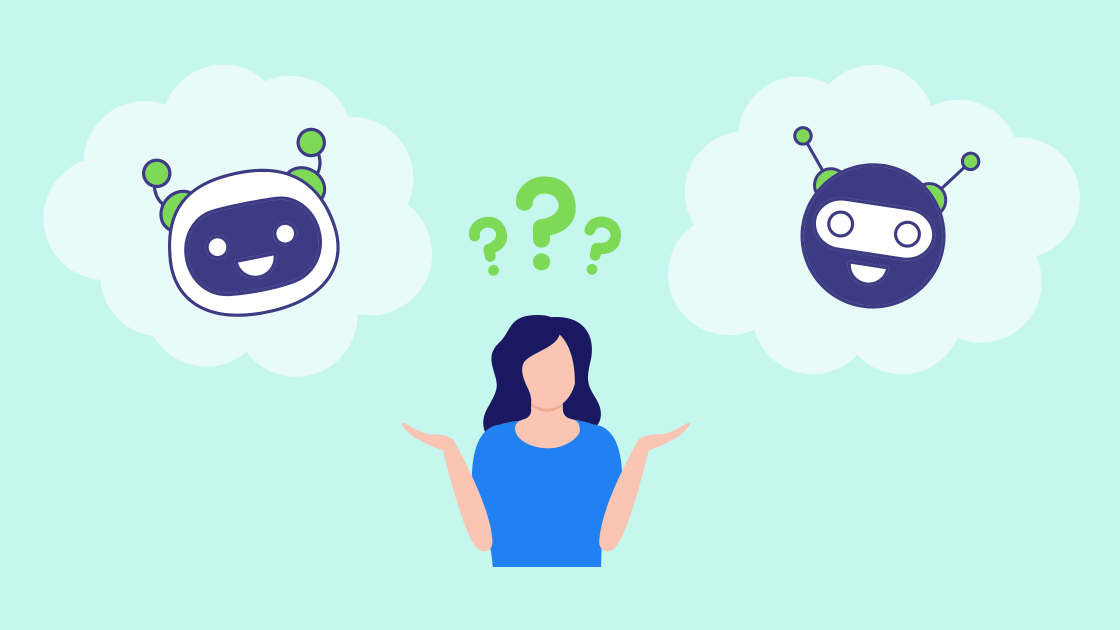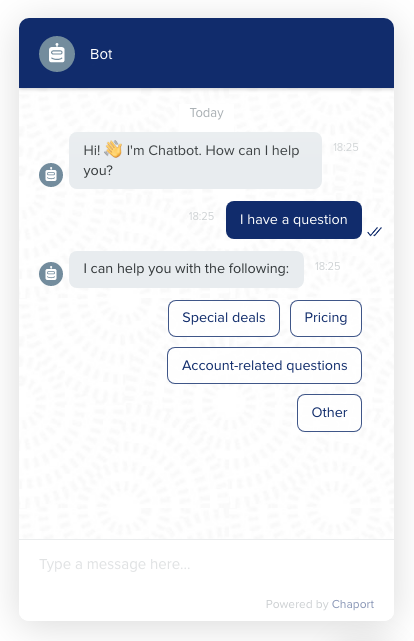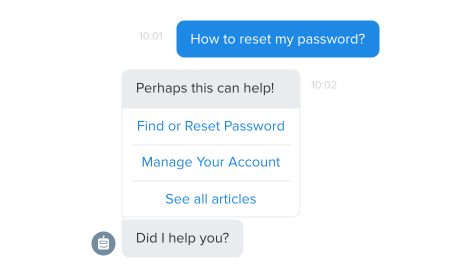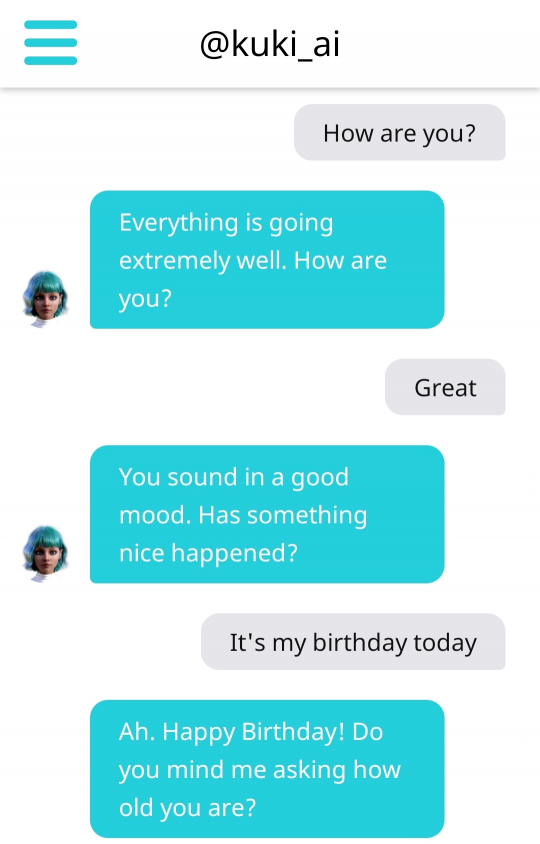Types of Chatbots:
How to Choose the Right One


The popularity of various chat apps is growing, with millions of messages sent every minute. Texting has become the dominant way people communicate in the modern world.
Chatbots are very similar to the messaging applications we are used to: they allow us to get instant responses, send messages from anywhere, and save time. The key difference is that you’re talking with a software program, not with a living person.
The number of businesses using chatbots is growing as well. Back in 2018, there were more than 300,000 active bots on Facebook’s Messenger. Now imagine the total number of bots that are spread all over the internet today, including other messengers, social media, and websites. That number must be mind-blowing!
The truth is that chatbots are becoming a necessary tool for most businesses. They automate multiple tasks, boost productivity, and even increase sales. There are different types of chatbots available on the market, and it is important to understand which one can add the most value to your business.
If you are looking for a chatbot but not sure how to choose the right one, this article will help you. We will look at different types of chatbot technology, their functionalities, and their applications. Let’s get started!
According to the way they work, chatbots can be divided into two main types: rule-based (scripted) and AI chatbots.
Rule-based, or scripted chatbots, as their names suggest, work according to a set of predefined rules. Their answers are always predetermined by a given scenario. Scripted bots can be further divided into menu-based and keyword-based chatbots.
Menu-based chatbots
This is the most common type of scripted chatbot. Basically, menu-based bots drive the conversation with a user by offering them certain reply options and providing them with predefined answers. Possible reply options are offered in the form of buttons, so this type of chatbot can also be called button-based.
Menu-based chatbots have a clear structure that can be presented in the form of a decision tree. The root of a chatbot decision tree is the initial question. Usually, this is a greeting message with an offer to help, such as “Hi! I’m Chatbot. How can I help you?”
Along with the first message, the user receives reply options: these are the branches of the tree that predefine further courses of action. To go to the next step of the conversation, the user needs to choose one of the options.
Let’s say our chatbot offers the following options: “I have a question”, “Just browsing”, “I want a demo”. If the user chooses the “I have a question” button, the chatbot might need additional information that can help to give a relevant answer. The chatbot can ask the user to specify the question.
For example, the bot can ask the user to choose from the following options: “Special deals”, “Pricing”, “Account-related questions” and “Other”.

You can add any number of branches, but we advise you not to get carried away. If the script is too long and complicated, your customers will get bored easily. Try to keep the chatbot scenario clear and precise.
This type of rule-based chatbot is widely used by companies from different industries, so you’ve probably interacted with such bots when visiting websites. Although button-based bots are simple enough, they can perform multiple tasks such as answering FAQs, collecting and transferring user information, and connecting users with live chat operators.
Pros:
Cons:
Keyword-based chatbots
Keyword-based chatbots are somewhat similar to menu-based ones. Their responses are also predefined, but unlike menu-based bots, they can recognize what users type and give an answer based on keywords.
This type of chatbot doesn’t use clarifying questions or a decision-tree approach to return a final answer. If a user asks a question, the chatbot immediately responds and offers a solution (or at least tries to). Of course, it’s not possible to write a script with answers to all possible customer questions. If a bot can’t find an answer that matches the keyword, it sends a message like “I’m sorry, I didn’t get that. Try again?”
For example, if a customer types “I want to schedule a demo”, the bot would likely recognize the words “schedule” and “demo” and return a matching reply based on those keywords.
However, chatbots may not be able to recognize typos, slang, or inaccurate word order. Let’s say a user types “How do I change my email adress?” If you don’t add possible typos of the word “address”, your chatbot won’t understand the question, and your customer will get a frustrating error message. To create an effective keyword-based chatbot, you need to include a wide range of slang terms and possible misspellings when writing the script.
You should also note that keyword-based chatbots may fail to give the right answer when they have a lot of related questions with similar keywords. In such cases, it makes sense to use a button-based approach.
Keyword recognition is often used for Q&A automation. For example, businesses often use FAQ bots that can suggest articles from the knowledge base according to keywords from customers’ questions. This tool can greatly improve customer self-service.
For example, Chaport has the FAQ bot feature. It allows you to create a knowledge base and activate a chatbot that can suggest articles based on keywords from your customers’ questions.

Pros:
Cons:
These types of chatbots utilize Machine Learning (ML) and Artificial Intelligence (AI). AI chatbots don’t have predefined scripts — they solve problems and generate messages autonomously.
To understand what they should do or say in a given situation, AI bots use so-called training data. This data can include your previous conversations with customers and other relevant information to help understand the context. After launching an AI chatbot, its training continues, as they can self-learn from the data gathered during interactions with customers.
Their ability to produce their own answers helps personalize communication with customers and make the conversation sound more natural. However, this feature also means that you have less control over chatbot responses and conversation outcomes.
Some chatbots can be incredibly human-like, such as a chatbot called Mitsuku, a four-time winner of the Loebner Prize Turing Test. However, creating a truly sophisticated AI chatbot will take a huge amount of time, effort, and money.

Conversation with Mitsuku | Source: kuki.ai
Pros:
Cons:
First of all, you need to define what goal you want to achieve with a chatbot. Different types of bots can be used for different goals. You should analyze your customers’ pain points and determine what your chatbot should do to improve your customer experience.
The tasks are different for each business. For example, if you want to automate your knowledge base and enhance customer self-service, a keyword-based chatbot will be a good solution for you.
Menu/button-based chatbots can also handle basic customer questions. Besides that, they are perfect for surveys, lead generation, sales support, and other tasks that require a clearly structured scenario.
AI chatbots are good for businesses that have a huge variety of tasks that demand a high level of flexibility. Usually, AI chatbots are used by large companies with thousands of customer queries a day.
When choosing a chatbot for your business, think about customer experience. What would be more convenient for your customers: to type the whole message manually or choose from the offered options? This may depend on the task.
For some basic questions, it would be better to use a keyword- or button-based chatbot. A lead generation bot also shouldn’t overload your customers with extra actions such as typing long messages. If you want to create a chatbot for more complicated and varied queries, then it may be a good idea to try AI.
Another important thing to consider is your budget. The market is full of various chatbot solutions that can vary in price. Their costs start from $0 and may go up to thousands of dollars.
AI chatbots are the most expensive types of chatbots due to their complexity in development. Consider what value AI can bring to your customers and your company. If it’s not a top priority right now, perhaps it’s better to start with rule-based bots, which are much more affordable.
You should also remember that there are different ways to create a chatbot. If you need a fully customized solution designed specifically for your business, then you can build a chatbot from scratch. In this case, you will need to hire a skilled team of developers.
If you are looking for a faster and more affordable solution, you can use third-party chatbot platforms. Usually, they offer no-code chatbot builders and work on a subscription basis. For example, in Chaport, you can create and use chatbots on your website for $23 per month.
There are three main types of chatbots available on the market: menu/button-based, keyword-based, and AI-based. All of them can bring excellent benefits to businesses, however, each chatbot type can perform different functions.
What is right for your business will depend on multiple things, such as the tasks you’re going to solve, your customers’ preferences and needs, the number of incoming queries, and your budget.
We recommend starting with rule-based chatbots to test the waters. In Chaport, you can try them out for free after signing up. This will give you a clear understanding of how they work and whether they meet your requirements.
And if you have any questions about chatbots, drop us a message in our live chat. Our support team will be happy to help you!
